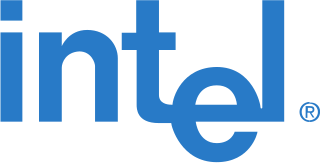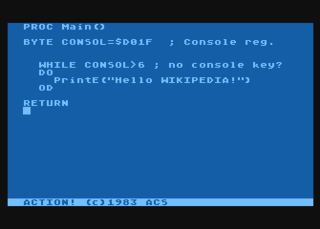Related Research Articles
The byte is a unit of digital information that most commonly consists of eight bits. Historically, the byte was the number of bits used to encode a single character of text in a computer and for this reason it is the smallest addressable unit of memory in many computer architectures. To disambiguate arbitrarily sized bytes from the common 8-bit definition, network protocol documents such as The Internet Protocol refer to an 8-bit byte as an octet. Those bits in an octet are usually counted with numbering from 0 to 7 or 7 to 0 depending on the bit endianness. The first bit is number 0, making the eighth bit number 7.

The 8086 is a 16-bit microprocessor chip designed by Intel between early 1976 and June 8, 1978, when it was released. The Intel 8088, released July 1, 1979, is a slightly modified chip with an external 8-bit data bus, and is notable as the processor used in the original IBM PC design.

Pascal is an imperative and procedural programming language, designed by Niklaus Wirth as a small, efficient language intended to encourage good programming practices using structured programming and data structuring. It is named in honour of the French mathematician, philosopher and physicist Blaise Pascal.

UCSD Pascal is a Pascal programming language system that runs on the UCSD p-System, a portable, highly machine-independent operating system. UCSD Pascal was first released in 1977. It was developed at the University of California, San Diego (UCSD).
Turbo Pascal is a software development system that includes a compiler and an integrated development environment (IDE) for the Pascal programming language running on CP/M, CP/M-86, and DOS. It was originally developed by Anders Hejlsberg at Borland, and was notable for its extremely fast compiling times. Turbo Pascal, and the later but similar Turbo C, made Borland a leader in PC-based development.

BBC BASIC is a version of the BASIC programming language released in 1981 as the native programming language for the BBC Micro home/personal computer, providing a standardized language for a UK computer literacy project of the BBC. It was written mainly by Sophie Wilson.

In mathematics, the sieve of Eratosthenes is an ancient algorithm for finding all prime numbers up to any given limit.

Atari BASIC is an interpreter for the BASIC programming language that shipped with the Atari 8-bit family of 6502-based home computers. Unlike most BASICs of the home computer era, Atari BASIC is not a derivative of Microsoft BASIC and differs in significant ways. It includes keywords for Atari-specific features and lacks support for string arrays, for example.
Interlisp is a programming environment built around a version of the programming language Lisp. Interlisp development began in 1966 at Bolt, Beranek and Newman in Cambridge, Massachusetts with Lisp implemented for the Digital Equipment Corporation (DEC) PDP-1 computer by Danny Bobrow and D. L. Murphy. In 1970, Alice K. Hartley implemented BBN LISP, which ran on PDP-10 machines running the operating system TENEX. In 1973, when Danny Bobrow, Warren Teitelman and Ronald Kaplan moved from BBN to the Xerox Palo Alto Research Center (PARC), it was renamed Interlisp. Interlisp became a popular Lisp development tool for artificial intelligence (AI) researchers at Stanford University and elsewhere in the community of the Defense Advanced Research Projects Agency (DARPA). Interlisp was notable for integrating interactive development tools into an integrated development environment (IDE), such as a debugger, an automatic correction tool for simple errors (via do what I mean software design, and analysis tools.

The Z8000 is a 16-bit microprocessor introduced by Zilog in early 1979. The architecture was designed by Bernard Peuto while the logic and physical implementation was done by Masatoshi Shima, assisted by a small group of people. In contrast to most designs of the era, the Z8000 did not use microcode which allowed it to be implemented in only 17,500 transistors.

The iAPX 432 is a discontinued computer architecture introduced in 1981. It was Intel's first 32-bit processor design. The main processor of the architecture, the general data processor, is implemented as a set of two separate integrated circuits, due to technical limitations at the time. Although some early 8086, 80186 and 80286-based systems and manuals also used the iAPX prefix for marketing reasons, the iAPX 432 and the 8086 processor lines are completely separate designs with completely different instruction sets.

TI BASIC is an ANSI-compliant BASIC programming language interpreter built into the 1979 Texas Instruments TI-99/4 home computer and its improved 1981 version, the TI-99/4A.

The history of programming languages spans from documentation of early mechanical computers to modern tools for software development. Early programming languages were highly specialized, relying on mathematical notation and similarly obscure syntax. Throughout the 20th century, research in compiler theory led to the creation of high-level programming languages, which use a more accessible syntax to communicate instructions.

PROMAL is a structured programming language from Systems Management Associates for MS-DOS, Commodore 64, and Apple II. PROMAL features simple syntax, no line numbers, long variable names, functions and procedures with argument passing, real number type, arrays, strings, pointer, and a built-in I/O library. Like ABC and Python, indentation is part of the language syntax.

Action! is a procedural programming language and integrated development environment written by Clinton Parker for the Atari 8-bit family. The language, which is similar to ALGOL, compiled to high-performance code for the MOS Technologies 6502 of the Atari computers. Action! was distributed on ROM cartridge by Optimized Systems Software starting in 1983. It was one of the company's first bank-switched "Super Cartridges", with a total of 16 kB of code.
S-algol is a computer programming language derivative of ALGOL 60 developed at the University of St Andrews in 1979 by Ron Morrison and Tony Davie. The language is a modification of ALGOL to contain orthogonal data types that Morrison created for his PhD thesis. Morrison would go on to become professor at the university and head of the department of computer science. The S-algol language was used for teaching at the university at an undergraduate level until 1999. It was also the language taught for several years in the 1980s at a local school in St. Andrews, Madras College. The computer science text Recursive Descent Compiling describes a recursive descent compiler for S-algol, implemented in S-algol.
In mathematics, the sieve of Sundaram is a variant of the sieve of Eratosthenes, a simple deterministic algorithm for finding all the prime numbers up to a specified integer. It was discovered by Indian student S. P. Sundaram in 1934.
The Creative Computing Benchmark, also called Ahl's Simple Benchmark, is a computer benchmark that was used to compare the performance of the BASIC programming language on various machines. It was first introduced in the November 1983 issue of Creative Computing magazine with the measures from a number of 8-bit computers that were popular at the time. Over a period of a few months, the list was greatly expanded to include practically every contemporary machine, topped by the Cray-1 supercomputer, which ran it in 0.01 seconds.
The Rugg/Feldman benchmarks are a series of seven short BASIC programming language programs that are used to test the performance of BASIC implementations on various microcomputers. They were published by Tom Rugg and Phil Feldman in the June 1977 issue of the US computer magazine, Kilobaud.

A BASIC interpreter is an interpreter that enables users to enter and run programs in the BASIC language and was, for the first part of the microcomputer era, the default application that computers would launch. Users were expected to use the BASIC interpreter to type in programs or to load programs from storage.
References
Citations
- 1 2 3 4 Gilbreath 1981, p. 180.
- ↑ Knuth 1969, pp. 416, 658.
- ↑ Gilbreath 1981, pp. 181–190.
- 1 2 Gilbreath 1981, pp. 194.
- ↑ Gilbreath 1981, pp. 195.
- ↑ Gilbreath 1981, pp. 193.
- 1 2 Gilbreath 1981, pp. 196.
- 1 2 Gilbreath & Gilbreath 1983, p. 294.
- ↑ Gilbreath & Gilbreath 1983, p. 292.
- ↑ "HS/FORTH (advertisement)" (PDF). PC Tech Journal. October 1985. p. 132.
- ↑ "FORTH is now very.fast (advertisement)" (PDF). FORTH Dimensions. November–December 1985. p. 2.
- ↑ Ciarcia, Steve (1979). Ciarcia's Circuit Cellar, Volume 6. p. 133. ISBN 9780070109681.
- 1 2 Houston, Jerry; Brodrick, Jim; Kent, Les (August 1983). "Comparing C Compilers for CP/M-86". Byte. pp. 82–106.
- ↑ Kern, Christopher (August 1983). "Five C Compilers for CP/M-80". Byte. pp. 110–130.
- ↑ Phraner, Ralph (August 1983). "Nine C Compilers for the IBM PC". Byte. pp. 134–168.
- ↑ Hinnant, David (August 1984). "Benchmarking UNIX Systems: UNIX performance on microcomputers and minicomputers". Byte. pp. 132–135, 400–409.
- ↑ "Swift Sieve of Eratosthenes". 27 July 2015.
- ↑ "Sieve of Eratosthenes" . Retrieved 2 May 2019.
- ↑ O'Neill, Melissa (January 2009). "The Genuine Sieve of Eratosthenes". Journal of Functional Programming. 19 (1): 95–106. doi:10.1017/S0956796808007004. S2CID 1309380.
- ↑ Gilbreath 1981, p. 188.
- ↑ Gilbreath 1981, p. 186.
Bibliography
- Gilbreath, Jim (September 1981). "A High-Level Language Benchmark". Byte. pp. 180–198.
- Gilbreath, Jim; Gilbreath, Gary (January 1983). "Eratosthenes Revisited: Once More through the Sieve". Byte. pp. 283–325.
- Knuth, Donald (1969). The Art of Computer Programming Volume 2: Seminumerical Algorithms. Addison-Wesley. ISBN 978-0-201-89684-8.